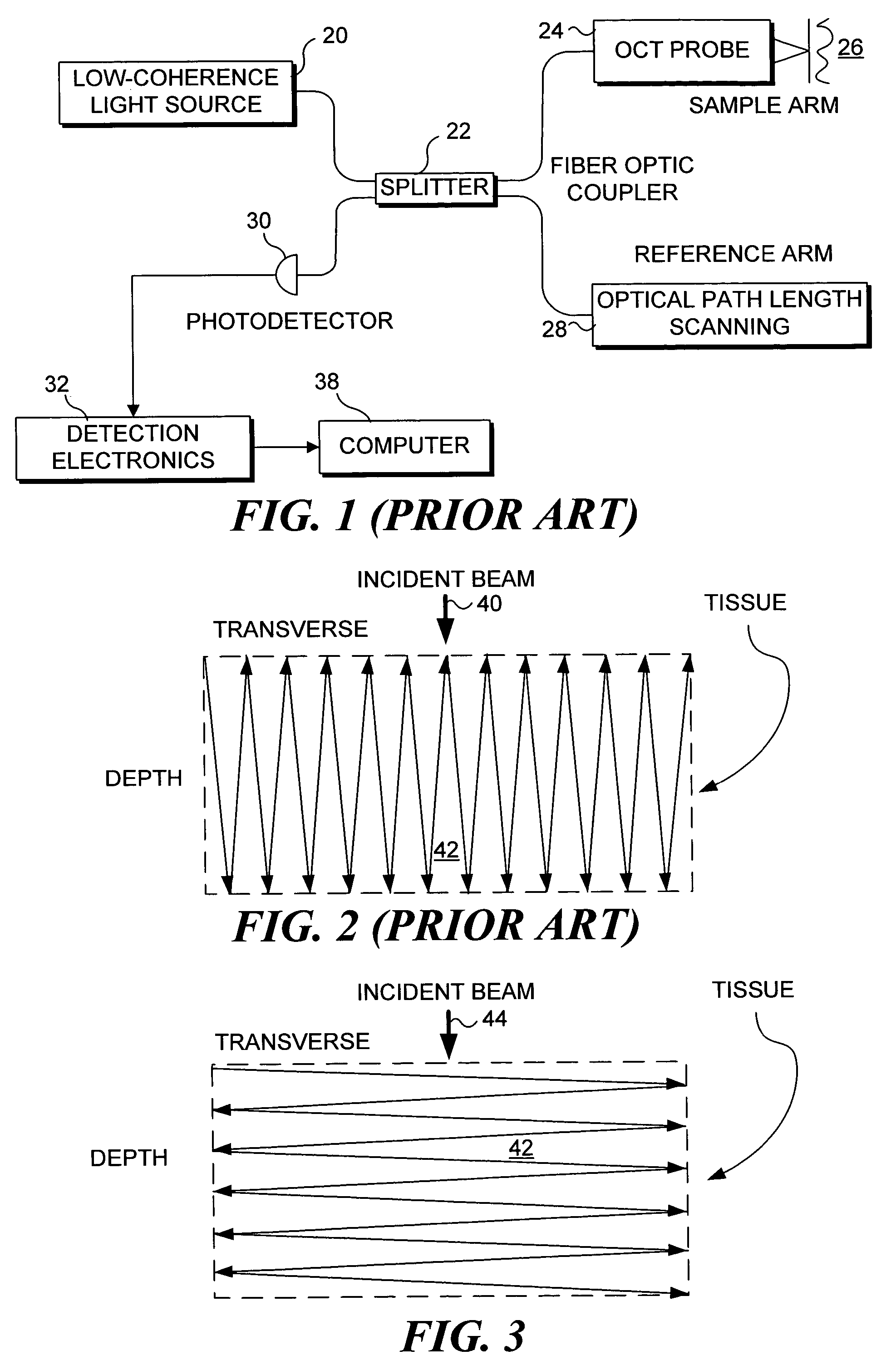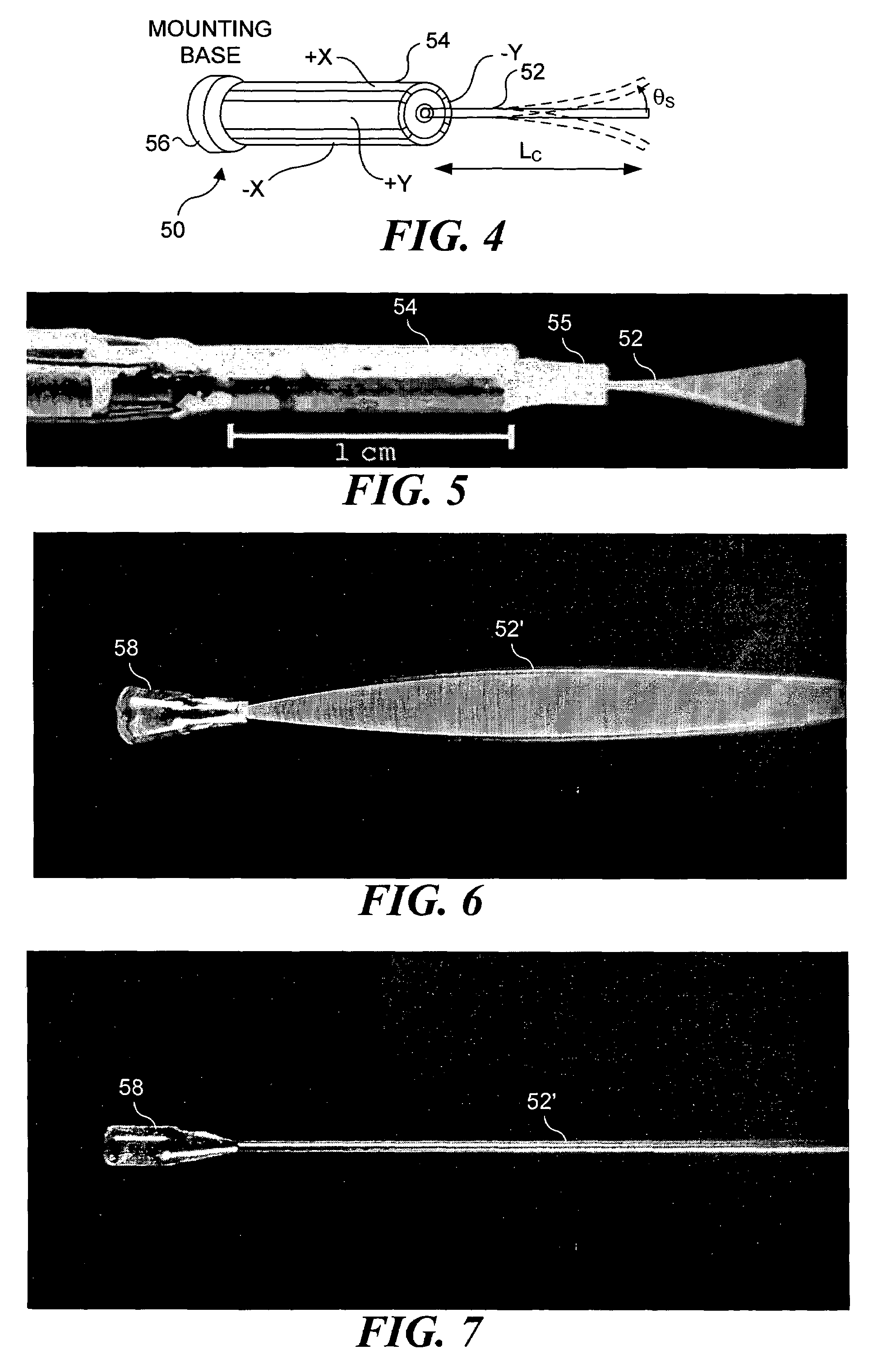Optical fiber scanner for performing multimodal optical imaging
a multi-modal, optical imaging technology, applied in the field of optical fiber scanners, can solve the problems of insufficient image resolution to provide the information required, unacceptably high false negative rate, and physicians' limited ability to detect and examine microscopic changes in early-stage neoplasia in vivo. , to achieve the effect of reducing back reflection
- Summary
- Abstract
- Description
- Claims
- Application Information
AI Technical Summary
Benefits of technology
Problems solved by technology
Method used
Image
Examples
first embodiment
[0069]An important feature of the present invention is the relatively slow change in the position of the focal point in regard to depth in a subject tissue after each transverse scan has been completed, or continuously during the transverse scanning. Accordingly, it is important to provide an acceptable focus-tracking scheme for the scanning miniature endoscope and the other embodiments of the present invention. a depth focus-tracking system 90 shown in FIG. 9 includes a micromotor 92 disposed adjacent to scanning endoscope 70 to precisely longitudinally translate the scanning endoscope assembly, i.e., the PZT actuator and imaging optics, relative to a subject that is being imaged. The working principle of a micromotor is well known in the art. For this exemplary embodiment, micromotor 92 has a 1.9 mm diameter and rotatably drives a threaded hollow shaft 94. The threaded hollow shaft has an inner diameter of more than 250 μm so that optical fiber 86 can easily pass through the open ...
embodiment 130
[0080]An embodiment 130 for varying depth focus tracking is shown in FIG. 13. Light emitted from cantilevered optical fiber 52 is focused by a lens system that includes a single lens or multiple lenses. FIG. 13 exemplifies a lens system including a lens 136 and a lens 134. Lens 136 is fixed in position relative to the distal end of cantilevered optical fiber 52, while lens 134 moves with its sliding track longitudinally, to shift the position of the focal point in a subject tissue (not shown) in the directions indicated by a double headed arrow 132. To adjust the dept focus tracking, a motor 126 is energized, rotatably driving a threaded shaft 128. Threaded shaft 128 is threaded into a shuttle nut 131, and the shuttle nut is coupled to lens 134, so that when the shuttle nut moves longitudinally, lens 134 is also moved longitudinally. Alternatively, lens 134 can be fixedly mounted in the supporting tube, and lens 136 can be coupled to shuttle nut 131, so that lens 136 is moved longit...
embodiment 186
[0083]FIGS. 16C and 16D illustrate a schematic view for an embodiment 186 comprising a side viewing endoscope 187 according to the present invention, in which a deformable membrane mirror (DMM) 193 is used with a beamsplitter 189 and employed to vary a depth of the focal point of the endoscope in the tissue (not shown) of a subject that is to the side of the endoscope, thereby providing depth focus tracking in this tissue. Beamsplitter 189 changes the optical path of the light from being along the longitudinal axis of endoscope 187, by directing the light from the DMM laterally toward the side and through window 207. A lead 201 couples DMM 193 to ground, while a lead 199 connects to an electrostatic actuator 195, which is mounted behind the DMM. A differential voltage, ΔV, of up to about 100 VDC can thus be selectively applied between the DMM and the electrostatic actuator to deflect the DMM from its planar state. Two stops 197 are included peripherally around the electrostatic actu...
PUM
| Property | Measurement | Unit |
|---|---|---|
| Frequency | aaaaa | aaaaa |
| Electric potential / voltage | aaaaa | aaaaa |
| Area | aaaaa | aaaaa |
Abstract
Description
Claims
Application Information
 Login to View More
Login to View More - R&D
- Intellectual Property
- Life Sciences
- Materials
- Tech Scout
- Unparalleled Data Quality
- Higher Quality Content
- 60% Fewer Hallucinations
Browse by: Latest US Patents, China's latest patents, Technical Efficacy Thesaurus, Application Domain, Technology Topic, Popular Technical Reports.
© 2025 PatSnap. All rights reserved.Legal|Privacy policy|Modern Slavery Act Transparency Statement|Sitemap|About US| Contact US: help@patsnap.com



